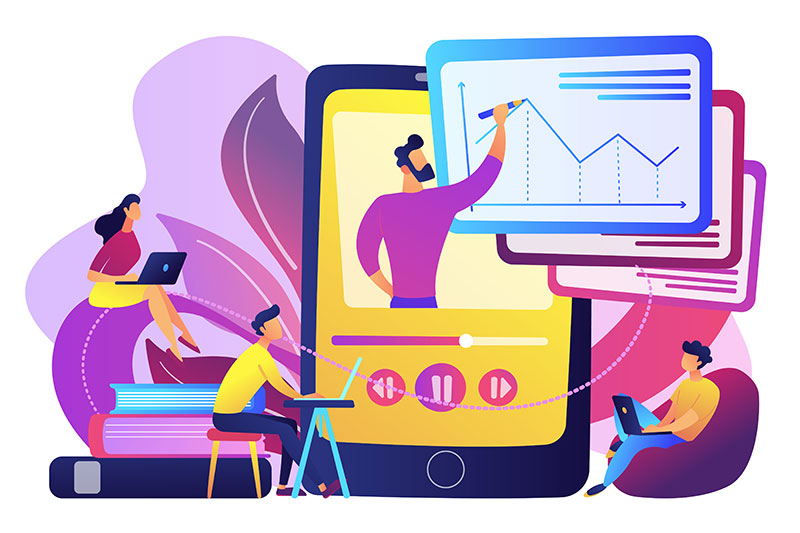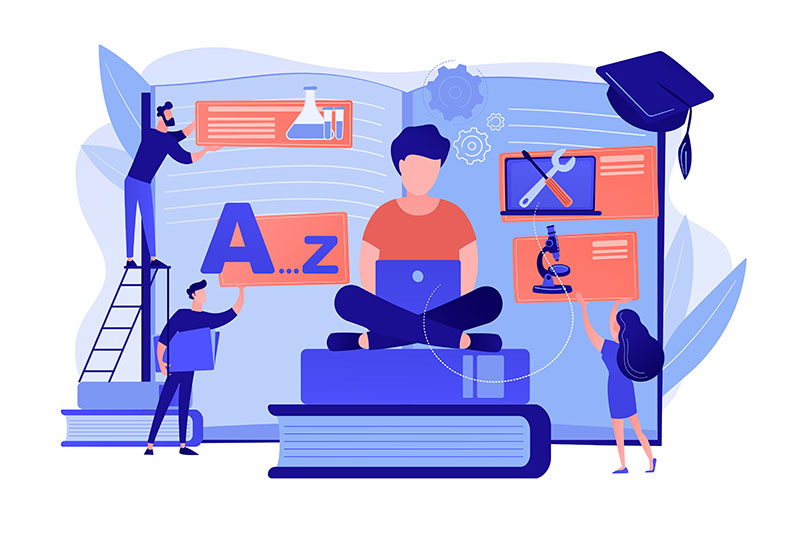eLearning Methods You Probably Didn’t Know About
The quest for knowledge in this fast-paced, progressing world is constant and almost eternal. Nobody knows what new techniques or methodologies are being developed right now to create the future within minutes. More than a decade ago, this thought of struggling for prosperity and learning would sound almost impossible, but here we are in the 21st century, making the impossible possible through eLearning.
If you’re unaware of the concept of e-Learning, you’re missing out big time. And if you’ve ever encountered someone connected to e-learning, you must know how blessed they feel about it. There’s no denying that e-learning has given impossible facilities to full-time employees and stay-at-home parents, specifically during Covid. And this is the main reason why the e-Learning market is expected to reach a height of $286.62 billion by 2023.
To partake in this technological breakthrough, you’ll have to educate yourself with the untold facts about e-Learning. From its different methods to the different risks and their solutions, including the concept of identity theft protection, here’s what you need to know.

What is eLearning?
First of all, let’s “brief” you on the basic concept of e-learning. If (by any chance) you think e-learning is only related to online education or electronics certification, then nope! E-Learning or electronic learning is an education system based on standardized tutelage spread in the different subject areas.
The subject area is as vast as it can be; you can study almost any type of craft, religion, or theory-based knowledge from the comfort of your home or board room.
The e-learning format is based on formalized tutoring that focuses on systematic and curriculum-based training.
What makes e-Learning so convenient is that it is an online-based education system dependent on computers, smartphones, laptops, and the king of the classroom – a good internet connection.
Although eLearning has always been beneficial, educationalists denied it over the years because it killed the classroom vibe or face-to-face learning element.
Fast forward to today, just as books are being replaced by smartphones and eReaders, a hybrid education system (physical-online mixed) is in line to replace the physical education system.
But this does not mean, of course, that classroom education will be completely replaced, as it offers advantages that go far beyond theory.
– Blended learning: how your school can combine online and offline teaching
Most Effective eLearning Methods
E-Learning is divided into two separate categories; asynchronous (recorded lectures) and synchronous (interactive sessions). And you’ll be thrilled to know that even though online learning or recorded video are popular mediums of eLearning, they’re not the only ones.
Below we have listed five of the most effective e-Learning methods that you probably didn’t know about.
Time Management Software
Time management software is a user-friendly tool that enables you to keep track of time and tasks.
This eLearning method belongs to both asynchronous and synchronous categories as the students have to manage learning, assignments and projects all by themselves in a class. Time management software allows you to create a schedule and act upon it in an organized manner.
Plus, it tracks time attendance to provide accurate time stats of how long you’ve been engaged with the content material and assignments separately. It’s better for the tutor and a large number of students active on the software. In short, the time management software boosts productivity by tracking accurate timings for both parties.
Mind Mapping Apps
Another effective method of eLearning is mind maps. Online mind maps are a fruitful way to memorize concepts using visuals. Mind maps are generally the best way to teach children since the human brain catches visual representation of information better than verbal discussion. Similarly, online mind maps or mind mapping apps are a great way to create a productive learning plan.
You can break down your academic to-do list into easily understandable and realistic patterns and then act upon them using collaboration tools. Collaboration tools in mind mapping apps enable sharing knowledge, ideas and notes with fellow mates, which further clears your vision.
Mind mapping apps also have a feature where you get extra content material like podcasts to get an insight into the upcoming lessons.
– 10 Excellent Podcast Marketing Strategies
Web-Based E-Learning
Next up on the list is Web-based e-Learning. As its name suggests, web-based eLearning is sourced from the World Wide Web and instructed by hybrid tutors. This means that the students get chances to interact with the tutor face-to-face a few times, and then they switch to self-learning mode.
The content material is sourced purely from the internet, although you may get a syllabus breakdown from the tutor.
There are different discussion forums where you discuss your research and lessons, like live sessions, emails, group chats, and online discussion forums. Hence web-based e-Learning is the internet-enabled transfer of knowledge and skills.
Educational Games
Ever heard of gamification? It is an approach in which gaming formats and tactics are applied to educational content. This approach includes quizzes, polls, and challenges. Educational games play a great role in eLearning as it helps to memorize things and pushes you to think fast.
Since most educational games come with a timer, your brain starts flashing with options and possibilities. It encourages active and creative learning, improves productivity and encourages fun learning.
You must have noticed that gamification has a lot of eye-catching visuals and sharp colors, that’s because they stimulate your thinking abilities and help you recognize patterns.
– How to apply gamification in eLearning
Social Media Platforms
Social media platforms such as Facebook, Instagram and Pinterest are the best e-Learning methods available for free. It is impossible not to learn from social media in today’s tech-savvy world.
Every day you learn something new without even trying, just by surfing through your social media. But how do you utilize it for eLearning? Simply by joining learning groups and pages.
Tutors usually have pages or groups for a particular subject, and they post content on it regularly. This content can be a video tutorial, a website link, a carousel post, or simply a group discussion. It is, without a doubt, the fastest and easiest mode of e-Learning.
Advantages and Disadvantages of E-Learning
With the info mentioned above, you must have had an idea why eLearning is gradually leading towards globalization. However, since everything has its pros and cons, e-Learning also comes with disadvantages and advantages. Head below and have a look at them.
Advantages
- E-Learning saves you both time and money. In both asynchronous and synchronous methods, you get to decide your schedule and attend classes from home or the office. The transportation costs, lab fees and meal charges are also cut down in e-Learning. Plus, e-learning institutes charge fewer fees than physical institutes.
- Another advantage of e-learning is that it gives you the privacy you need for maintaining focus. Since many students can’t perform well in groups and work better individually, this learning approach helps them a lot. It also allows you to learn at your own pace.
- The content material provided at physical institutes is confined to lectures only, while e-Learning provides more learning material. Moreover, the learning material is mostly interactive and engaging content.
- Lastly, the biggest advantage of online learning is that you have a variety of learning methods to choose from. For example, if you are interested in the audio to text approach, you have various sources available on the web. Similarly, you can choose an online institute or software that supports your e-Learning approach, like Coursify.me.
Disadvantages
- One disadvantage of eLearning is that it is a solitary activity, without the interaction of a classroom. Therefore, it is recommended that tutors create discussion groups so that students can interact and exchange ideas.
- The next big con of online learning is that you must have a good internet connection. Since the asynchronous and synchronous methods require an internet connection to download and play the content or class, you must have a reliable connection.
- Although e-Learning allows you to learn skills that could generate income, they don’t involve you in the practical work. However, your content material might include podcasts, articles, and guides for better understanding. Plus, most skills are tech-related, not craftsmanship.
- Identity theft is by far the biggest disadvantage of e-Learning. Luckily, technological development and identity theft protection has got your back.
Final Thoughts

So that’s how vast the area of eLearning is. And with the enhanced telecommunication and constantly developing technology, it won’t be wrong to say that e-learning is here to stay for good!
Although there are no more mixed reviews regarding e-Learning and the majority weighs in its favor, there are still some consideration factors. With that being said, the few disadvantages don’t stop online learning from becoming the ultimate tutelage network.
Summing up, eLearning is the future of education globally, and that’s why Coursify.me was created.
Coursify.me is a dynamic and customizable Learning Management System that provides all the resources you might need.
– Whats is a Learning Management System (LMS)
An LMS present in more than 60 countries, Coursify.me is ready for you to upload your courses and create a fully customized page for your company.
To learn more, visit our website, test the platform and see why we are the best option for your business.

